All-Star Squadron #43
Paging Dr Freud....Dr Freud you are wanted on the cover......
Creative Team: Roy Thomas-plot & Editor, Mike Baron-dialogue, Red Baron-Manfred von Richthofen, Arvell Jones-pencils, Velvet Jones-Eddie Murphy, Bill Collins-inks, Phil Collins-drummer and 2nd lead singer of Genesis, Cody Weiss-letters, codystarbuck-jokes & commentary, Gene-D'Angelo-colors, Michelangelo-Buonarroti.
Synopsis: The All-Stars have been defeated and Dr Daka orders their execution...
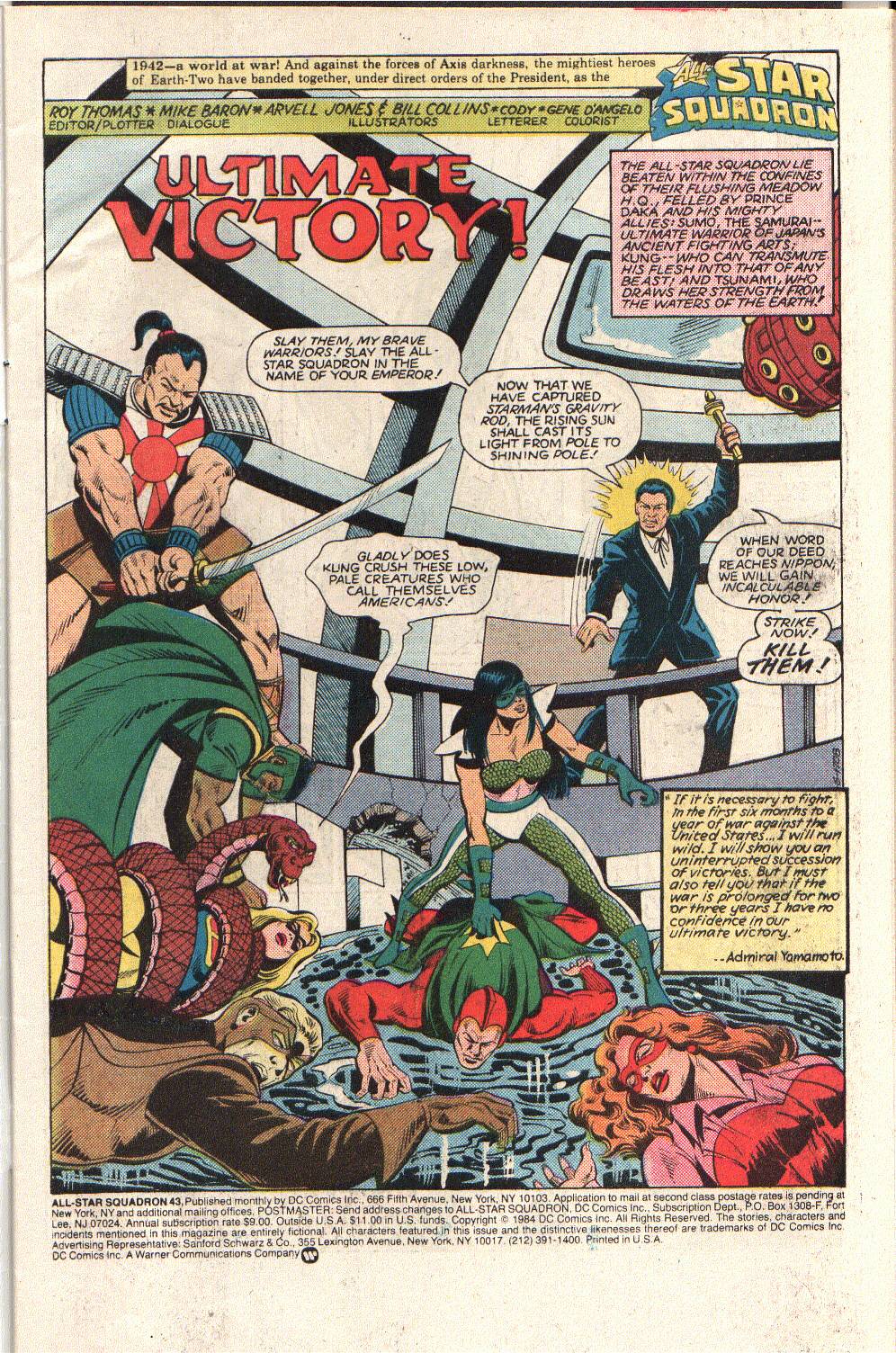
Have Dr Freud consult on that image of Liberty Belle, while he's at it.
Sumo and Tsunami question the honor of killing unconscious and valiant foes and Kung tells them to get over it and obey. Sumo swings down his katana, when...
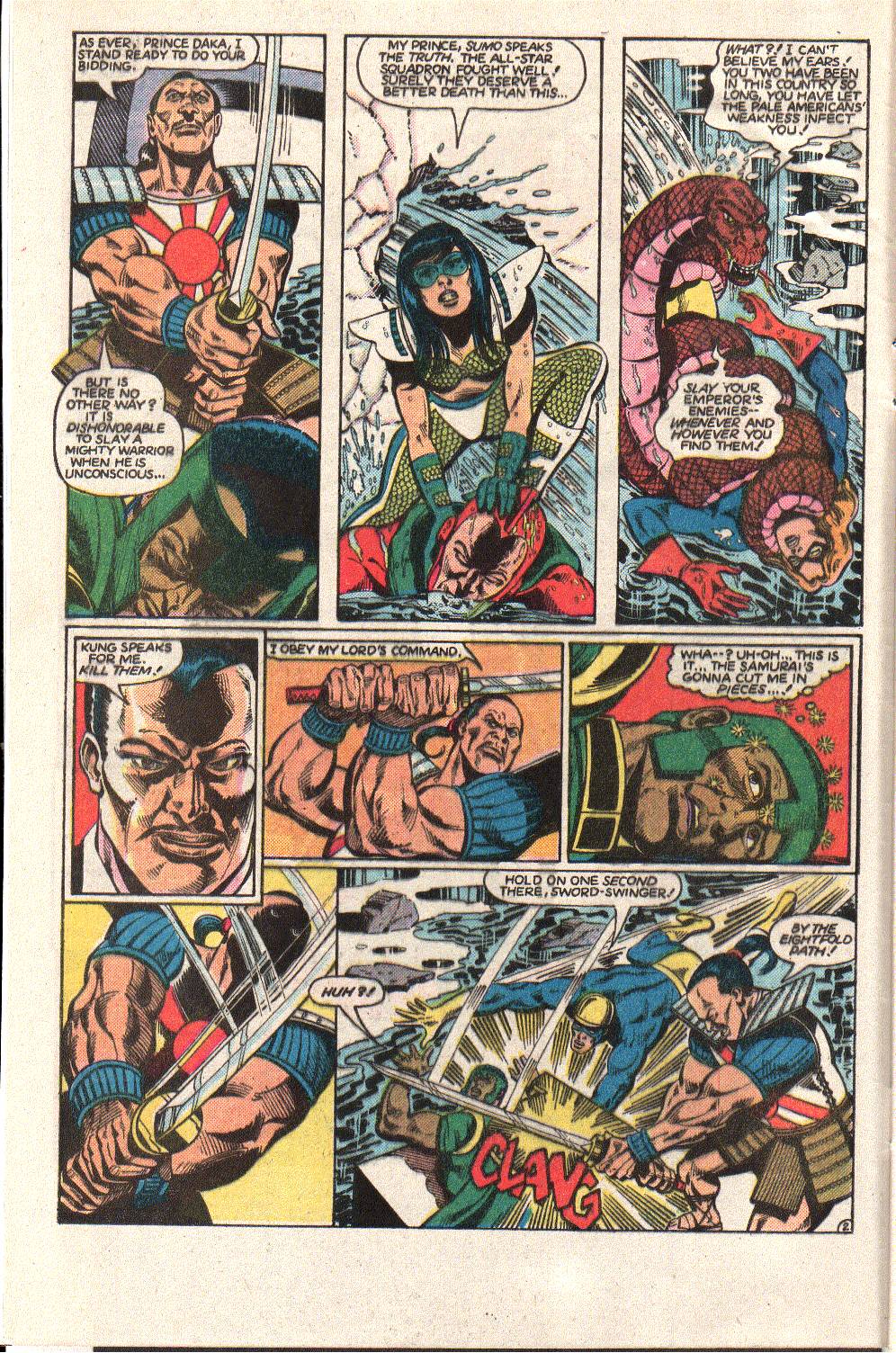
It's CaptainerGuardianfromAmerica! Guardian's shield holds and Daka tells Sumo to kill him and Guardian ducks and weaves and stumbles into Tsunami, causing her to crack her head on concrete and be taken out of the fight. Guardian holds his own against the samurai and Daka starts heckling from ringside. He decides to interfere, with the Hitachi...I mean Gravity Rod and gets a fireball to the hand and it flies into the palm of Ted Knight, who giggles and asks Murray how he is doing! It's now Starman, Firebrand, Guardian and Amazing Man vs Kung and Sumo the Samurai, as Daka is useless and Tsunami has been KOed. He makes like Bobby Heenan and vaults over the ropes, after telling Kung & Sumo to bring Liberty Belle as a hostage. Well, actually, he orders it then turns invisible and Firebrand holds back, lest she hit Libby. Starman orders the perimeter to be sealed and fires up the Gravity Rod. He scans for them, but they are gone. Tsunami wakes up to find Tarantula's gun pointed at her. He fires it and it wraps her in a webline, as he says he is gift wrapping her for the party tonight. Sounds like one of movie producer Don Simpson's bashes.
Firebrand and Tsunami exchange words about torture, American ideals, and "internment" camps.
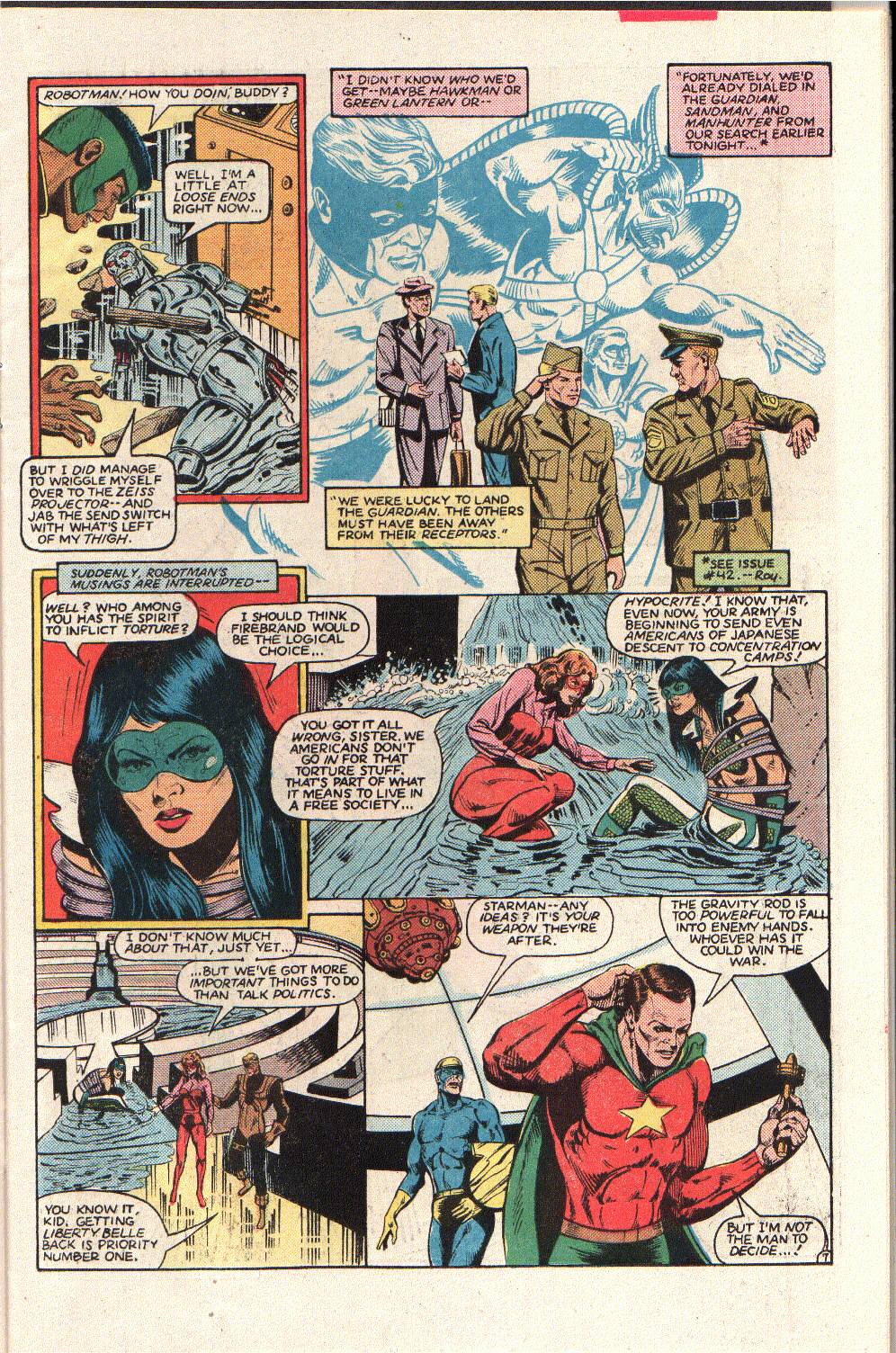
I don't know; I think uprooting people from their homes, imprisoning them without trial, and having them live and raise their children inside barbed wire and under the threat of machine gun towers to constitute mental torture.
The All-Stars are indecisive (every damn committee....). Firebrand takes charge and takes Ted's Gravity Rod and the captive Tsunami to go trade for Liberty Belle. tarantula chases after her. They spar on top of the Perisphere...
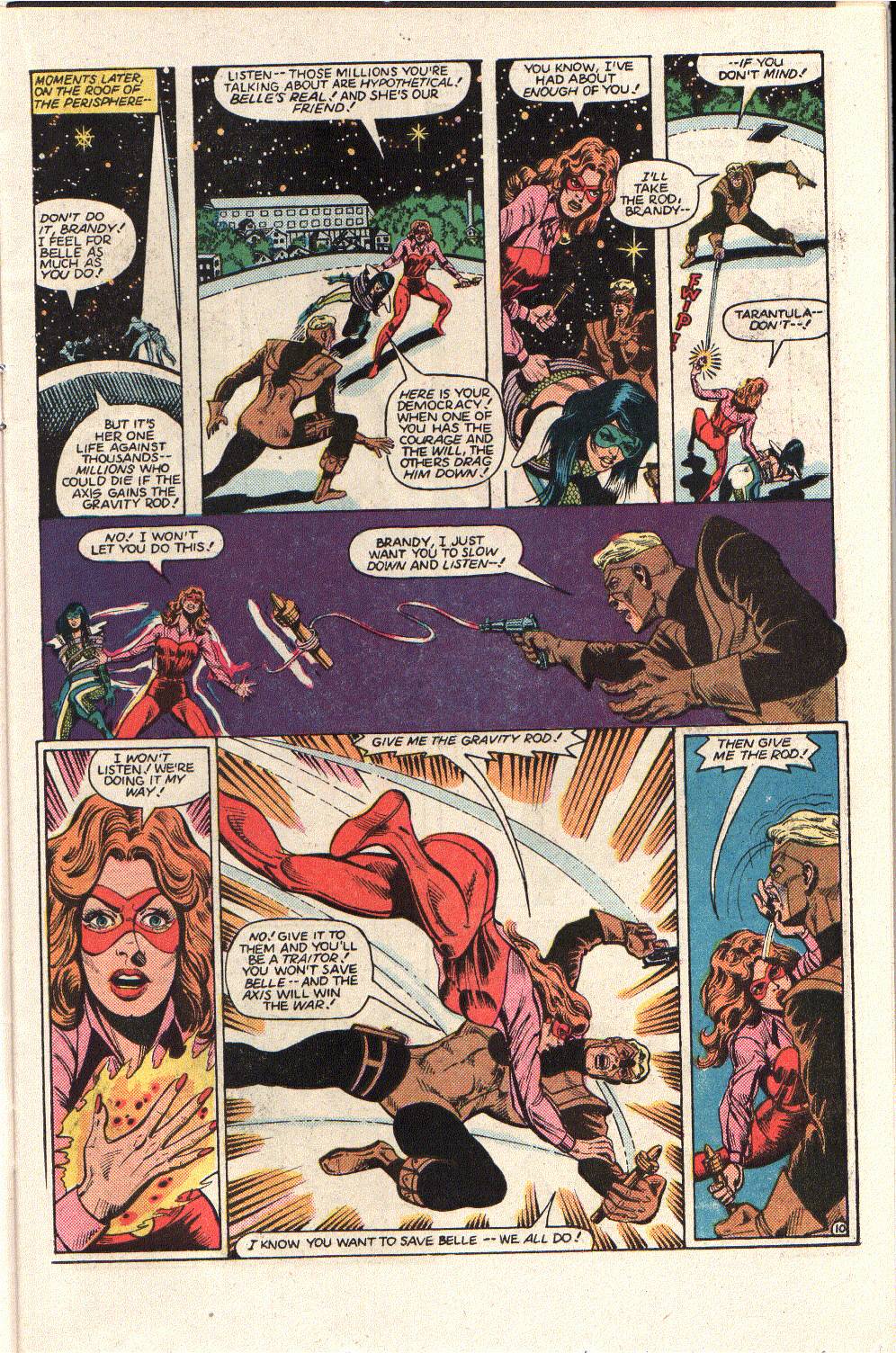
However, fighting on a curved surface is a bit dangerous and Tarantula goes over the side. Amazing Man touches the handball in his pocket and turns into rubber and absorbs most of the impact. He faces Firebrand again, but the others side with her and Starman continues the poor me bit and says he doesn't care. Tsunami is moved by the show of loyalty to their comrade. They take the Ascender to meet Daka, while John Law and Ted Knight repair Robotman. They get a call from Johnny Quick.
Meanwhile, the Japanese contingent are at the Bronx Zoo. Daka tosses a trussed up Liberty Belle around and she says the All-Stars will never bargain for her, just before the Ascender lands. They do just that..
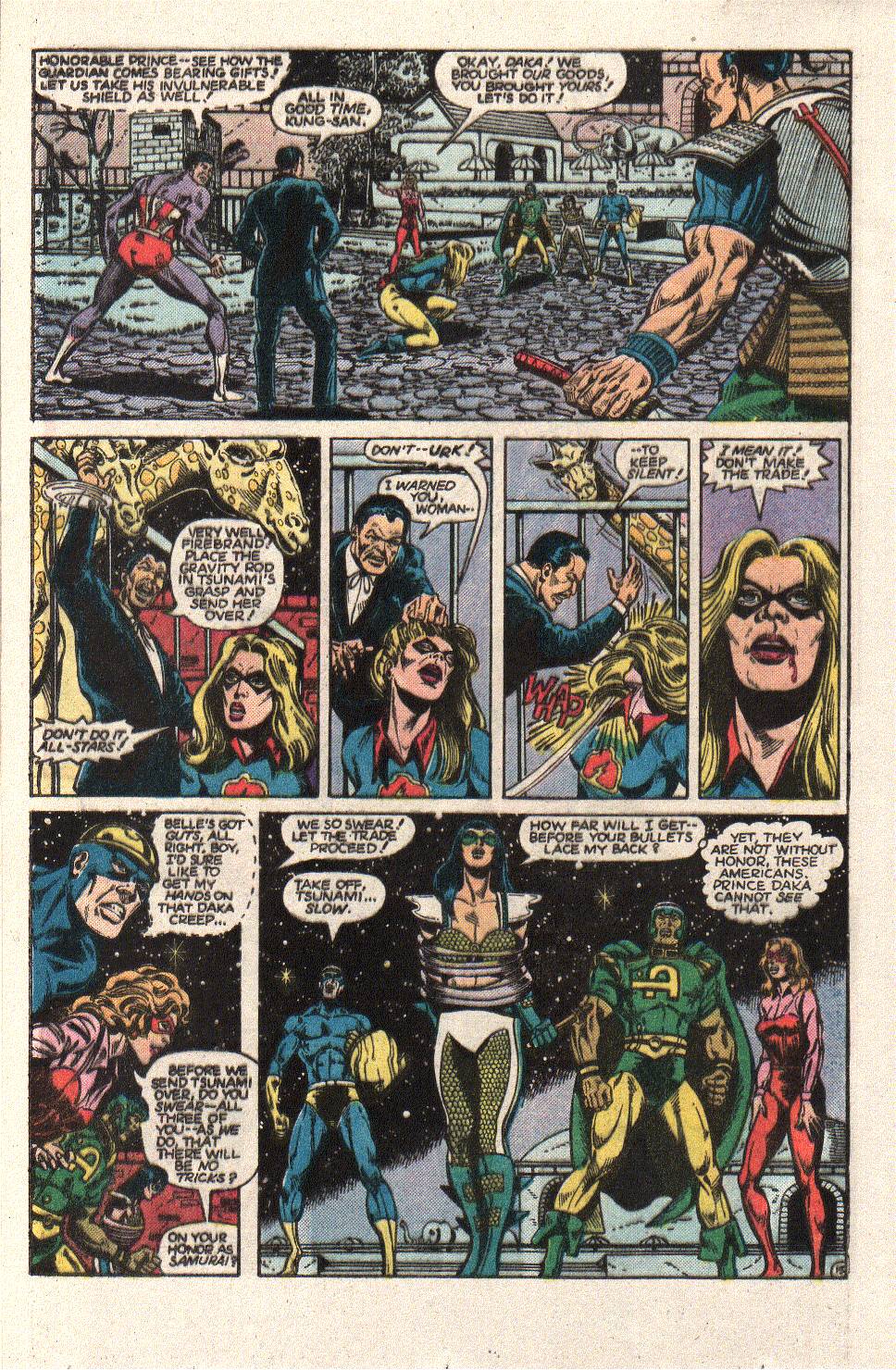
The women are sent to each side and pass each other in the middle, when Tsunami notices Kung and Daka conferring and spots a suspiciously loose cobblestone...
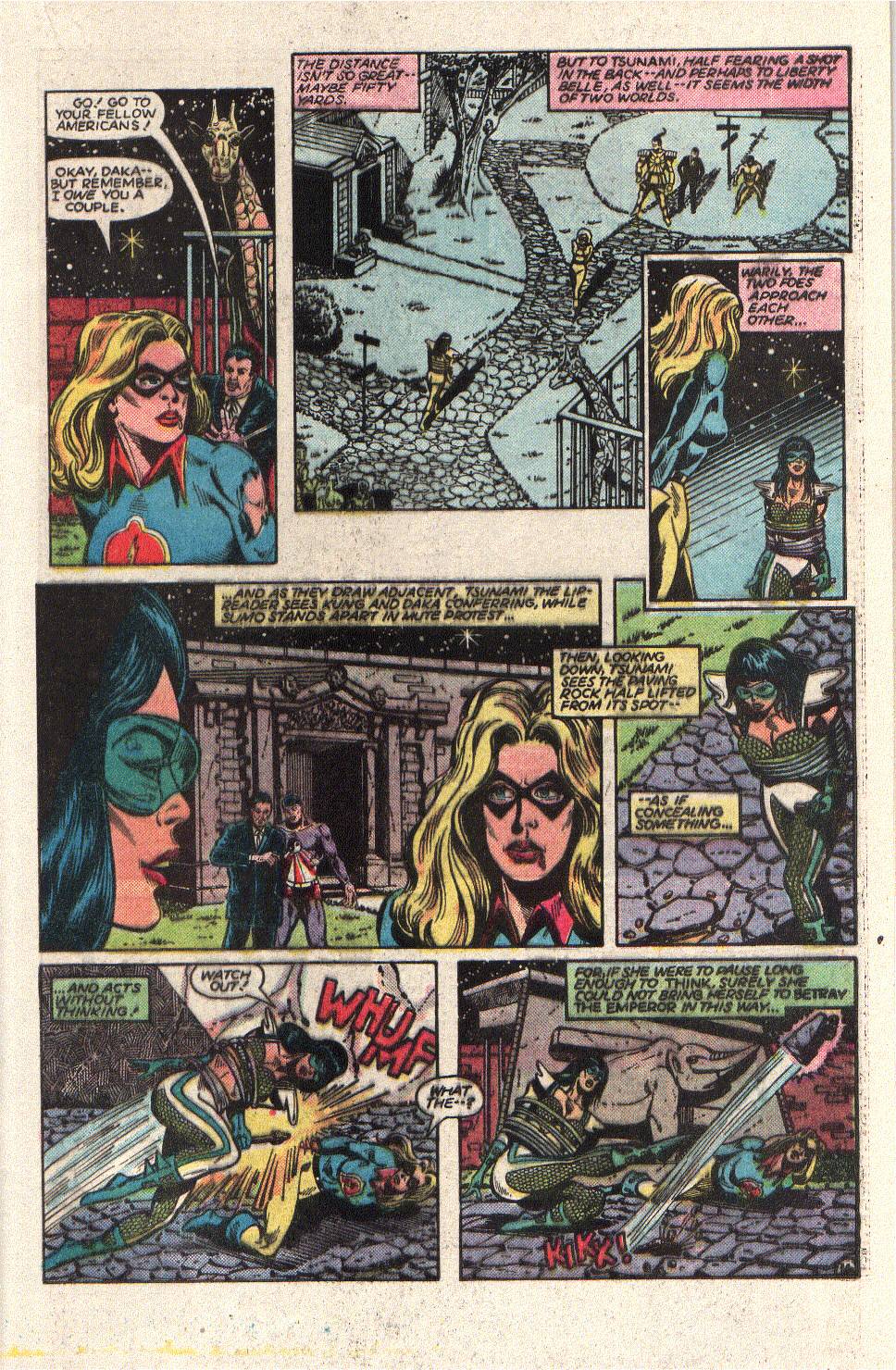
Sure enough, there was a mine there. Firbrand orders the All-Stars to attack and Daka sends his troops, for the Glory of the Emperor, which Sumo questions, but still attacks. Tsunami says she couldn't let the All-Stars die dishonorably, but she is off to fight with her side. Libby does a leg-scissor trip and brings her down. Sumo holds his own against Guardian and Amazing Man, but Firebrand has Kung on the run, wondering what beast doesn't fear fire? A salamander!
Kung turns into an elephant and scoops a trunkful of water and sprays it at Firebrand; but, misses. Guardian goes after Daka and uses his shield to deflect bullets. I've seen that somewhere before...
Tsunami gets to her feet and has the Gravity Rod and delivers it to Daka who then uses it, but Sumo knocks it free of Daka's hands, condemning him for his dishonor and offers to commit seppuku. Daka says vows to enemies mean nothing and orders Kung to crush them and the fight continues. They block Kung and Sumo does not fight. Tsunami gets free, but stands down. Daka and his men escape and Tsunami refuses to follow, but flees.
Dick Giordano's Meanwhile column is turned over to Michael Pickens, a fan who criticizes the portrayals of heroines in comics, including DC and denotes multiple techniques used to downplay female characters, consciously or unconsciously. He levels greater criticism at Marvel and Jim Shooter, but notes that Shooter doesn't allow guest columns. There is no reply at the end, just Pickens saying his piece. That's a pretty bold and even-handed thing to do.
Captain Canuck's George Freeman provides a pin-up of Sandman...
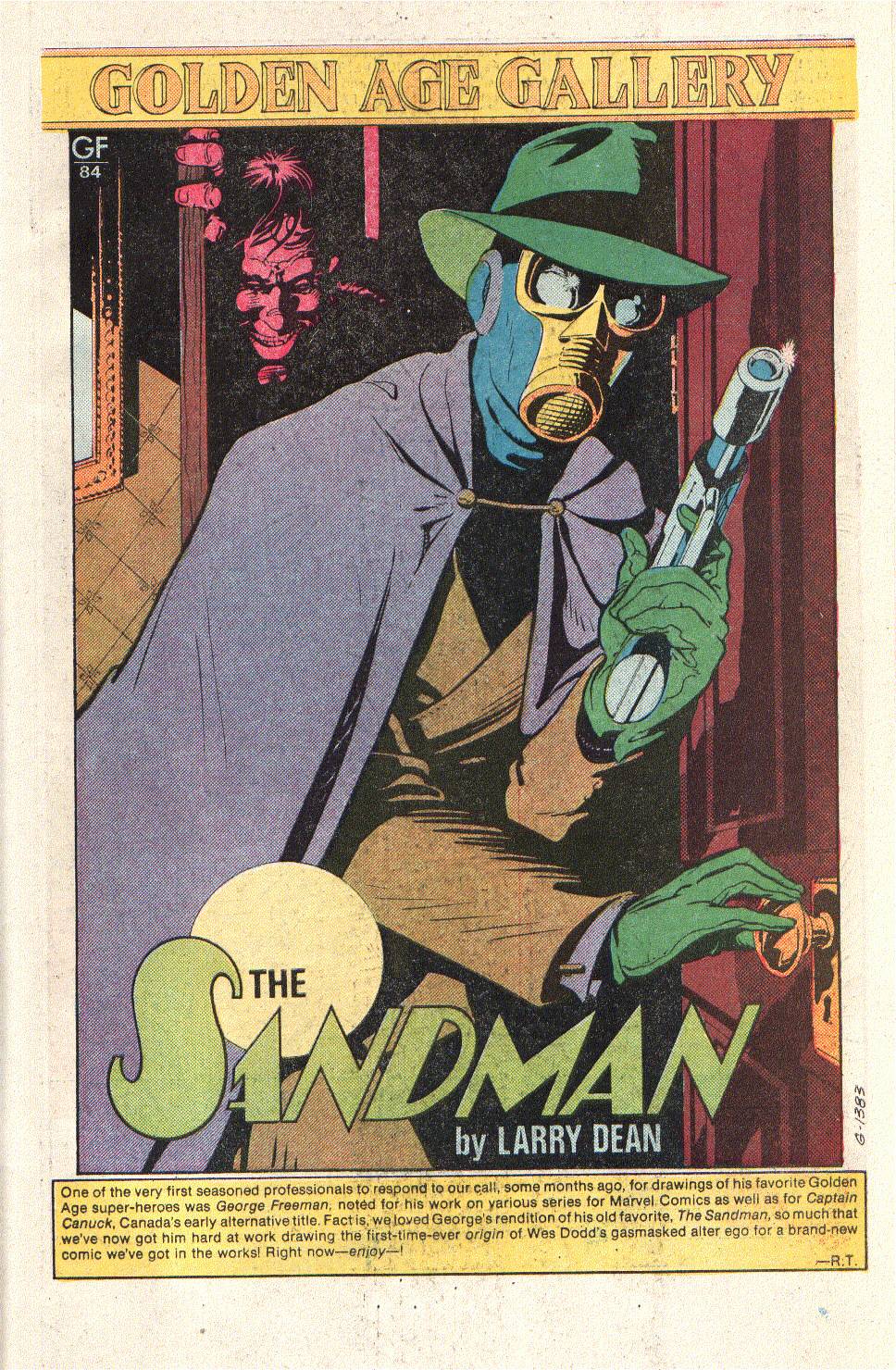
Roy mentions Freeman will handle the hero's Origin in an upcoming comic, which remains Secret! I'm stumped.....any ides?
America vs the JSA's Howard Bender and Dave Hut provide their version of the cover to All-Star Comics #5...
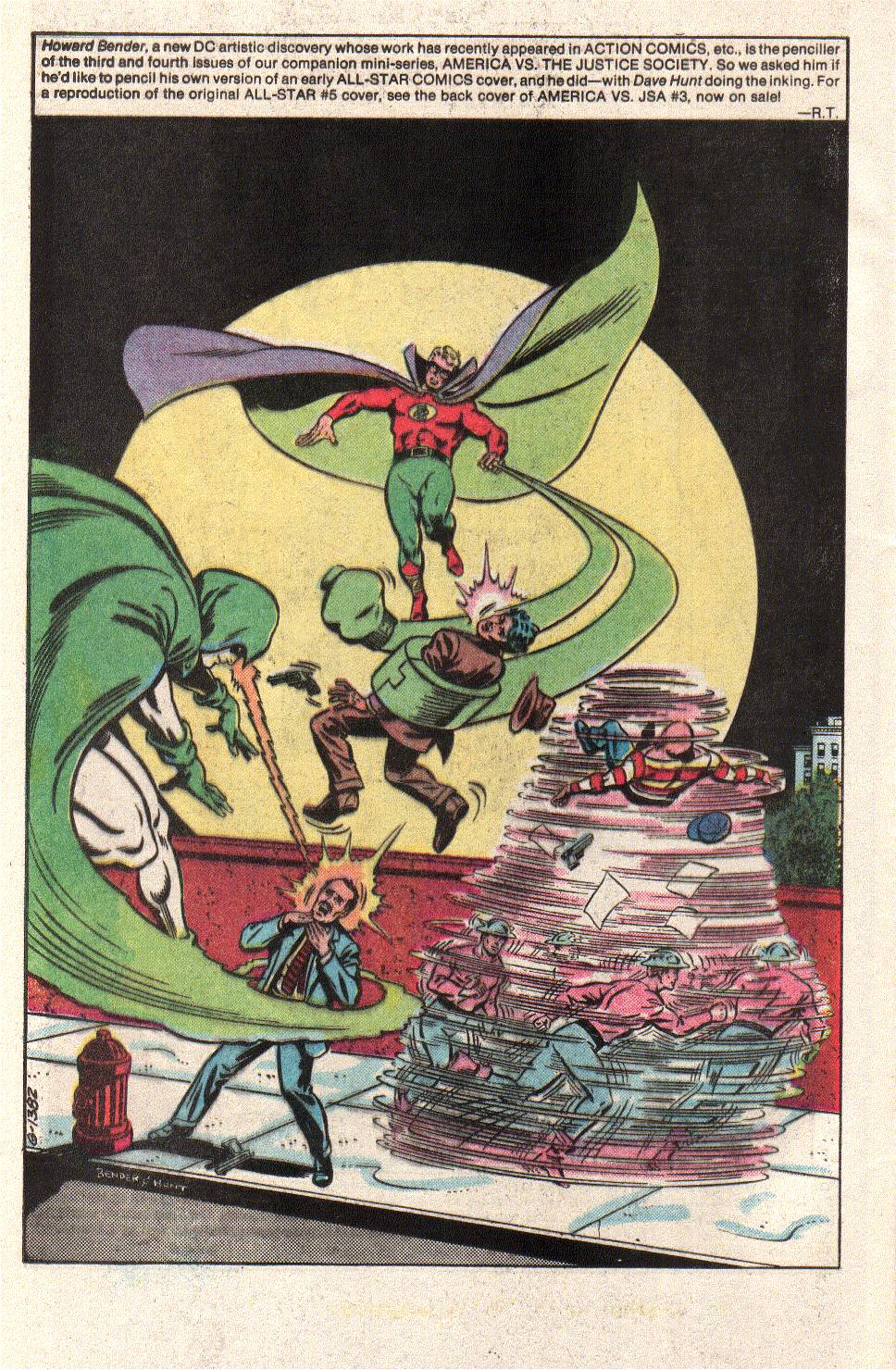
Don't know why the Flash is fighting Stripesy, though.......

Roy handles some administrative stuff (mentioning his workload and the guest dialoguers). Old buddy Jerry Bails delivers his thoughts on Annual #3. He suggests there is still a retcon story of how Hawkman became JSA chairman. Really? a whole issue devoted to the members voting? Sounds like a lot of people sitting at a table and writing names on paper. Look out Simon & Kirby! Beanworld's Larry Marder demands more Wayne Boring.
Back cover has an ad for a Ghostbusters computer game, for the Commodore 64. Inside back cover has an ad for GoBots models from Monogram. Man, I feel old! This comic came out in December, 1984, just after Christmas. I was spending my first Christmas break, home from college. I wore my midshipman uniform to Christmas Eve services, for the first time. Ronald Reagan had won re-election in a landslide, the month before (and I celebrated my 18th Birthday).
Thoughts: Interesting ending to the whole thing, with the action reflection philosophical points of view, not to mention some Wonder Twins action, via Kung. It is a little ambivalent whether Sumo follows Daka and Kung or not, though he isn't there, at the end and he isn't with Tsunami. Given the offer of seppuku, ritual suicide, I would assume he followed his leader. Seriously, though; Sumo the Samurai? Sonny Sumo was silly enough in The Forever People; but, he at least was built like a sumo wrestler. The Samurai version is gust really tall and muscular. Well, Gerry Conway created him, so it's his fault. I assume just calling him Samurai was nixed because of the Super Friends. I would have called him Musashi or even Mifune; but, I suspect I have read more Japanese history than Conway (had a class in it at the U of I, plus one in the Economy of Japan, as well as a whole lot of research on the samurai and their traditions, for a paper for said Japanese history class).
Tsunami gets turned babyface and will eventually return as a member of the young All-Stars, as part of Roy's post-Crisis continuity fixes, which will be ignored by just about everyone else at DC. Daka is 0 for 2; first Batman & Robin (while driving an average sedan, instead of the Batmobile and while living in a suburban home, not a stately manor) and now the All-Stars. I get Roy wanting to do an homage to that serial (which gets pretty racist, in some chapters); but, I would have chosen Sakima (The Masked Marvel) or Haruchi (G-Men vs the Black Dragon). What I really don't understand is why he didn't bring back Dragon King.
You know, Roy has created or used more Japanese super villains (Daka, Kung, Sumo, Tsunami, Dragon King) than German (Baron Blitzkrieg). He tries to correct that next issue.
Historical Notes: Roy opens with a quote from Amiral Isoroku Yamamoto, commander of the Imperial Japanese Navy and architect of the attack on Pearl Harbor. he was born to a samurai of intermediate rank and then adopted into the Yamamoto family, as they had no sons. He graduated from the Imperial Naval Academy in 1904 and served during the Russo-Japanese War, losing two fingers during the Battle of Tsushima. He attended the Naval Staff College and served two tours as a Naval Attache to the United States, after having already studied at Harvard. he was a major reformer of the Imperial Japanese Navy, focusing on the development of naval air power and pushing for the use of naval forces for gunboat diplomacy, rather than as transport of the Army. He opposed entering into a war with China and attacking the US and made the statement that Roy quotes, that he would run roughshod for 6 months; but, if the war dragged out 2 or 3 years, he could not promise victory. he is credited with saying that Japan had awakened a sleeping giant; but there is no actual documentation of him saying such a thing, publicly. He had seen America's industrial might and knew that any prolonged conflict favored the US, with its abundant natural resources, industrial strength and larger population, it was all a matter of numbers. His hope was that they could secure a security barrier around a Japanese Empire and negotiate a peace, if he could deliver a decisive blow quickly to the Pacific Fleet. Midway ended any such notions.
On April 18, 1943, Adm. Yamamoto set out on an inspection tour, in a Mitsubishi G4M "Betty" bomber. 4 days prior, US Naval Intelligence's "Magic" group had intercepted the itinerary of the tour, complete with ships and bases to be visited, escorts for his aircraft, and arrival and departure times. No historical record exists, but there is conjecture that FDR authorized Navy Secretary Frank Knox to "get Yamamoto." Knox left the decision to Adm. Nimitz, who after consulting Adm. Halsey, authorized a mission to intercept Yamamoto's aircraft. 18 P-38 Lightnings, from the 339th Fighter Squadron took off from Guadalcanal at 07:25. They flew a circular course to the interception point, over Bougainville to avoid Japanese radar installations and other forces in the Solomons. They arrived one minute early, at 09:34 and saw Yamamoto's flight descend into view from a light haze. The US planes were divide into a 4-plane kill team, with the rest as substitutes and top cover for any Japanese fighter response. The P-38 was chosen due to range and firepower, with drop tanks being a standard for the aircraft. The kill team jettisoned their auxiliary tanks and turned and made a power climb to intercept. Two of the kill team experienced failure in dropping their tanks and two planes made the attack. A6M Zeroes moved to engage them and Captain Thomas Lanphier turned to engage them head-on, while Lt Rex Barber went after the diving bombers. He came up on the rear of the first bomber and opened fire, hitting the right engine and rear fuselage. He kept firing until the plane lost control and went into a steep dive, and turned to engage the second bomber. It was trying to avoid Lt Besby Holmes, who had finally dropepd his tanks and Barber engaged as Holmes damaged the bomber's right engine. Barber finished off the plane, but metal debris damaged his own aircraft and he had to break off. The Betty crashed into the ocean, carrying Vice Adm Matome Ugaki, Yamamoto's Chief of Staff. Ugaki survived and was later rescued. The first aircraft crashed in the jungle on Bougainville and a rescue party discovered the wreckage and the dead body of Yamamoto, still sitting in his seat, grasping his katana in his hand. Post-mortem revealed he had been struck in the left shoulder and the head by .50 cal rounds from barber's P-38. The head wound killed Yamamoto. The details of his death were suppressed by the Military Government and Yamamoto was cremated and his ashes returned to Japan on board the Musashi, his flagship. He was given a state funeral, befitting a hero of the Empire of Japan.
The mission was an act of pure assassination, though it was not unprecedented. the British also made attempts on Field Marshal Rommel's life. The loss of Yamamoto was a major blow to the Imperial Japanese Navy, as he had dominated it for so long and was a powerhouse on the ruling Military Council. This further reduced the Navy bloc's political power and the Army dictated strategy even more. The irony of the mission is that much of the interception and translation of the messages that gave the itinerary were carried out by nisei soldiers of the Military Intelligence Service. Members of this unit would also aid operations in Burma, with Merrill's Marauders, travelling behind the lines, intercepting and translating battle orders and calling out conflicting orders. Much of their work was kept secret, until a 1972 Freedom of Information Act challenge.
April 1943-
Dietrich Bonhoeffer and lawyer Hans von Dohnanyi are arrested at Abwehr headquarters, by the Gestapo, while carrying incriminating documents, showing cooperation with British Intelligence. Dohnanyi had recruited Bonhoeffer into the Abwehr to protect him from the Nazis, who had already silenced his sermons and to act as a courier for the German resistance, passing on messages to the Allies, via clergy and religious figures in Norway, Sweden, Denmark and Switzerland. He was imprisoned until April of 1945, when Hitler order his, Dohnanyi and Adm Wilhelm Canaris' (head of the Abwehr) executions, at Flossberg Concentration Camp, just two weeks before US soldiers liberated the camp.
125 people are killed in the latest bombing of Aberdeen, Scotland.
On April 3, in Wellington, New Zealand, a riot broke out between US soldiers and New Zealand servicemen, over the admittance of Maori soldiers to the Allied Services Club, in the Battle of Manners Street. American soldiers from the segregated South objected to the Maoris and began blocking their entrance to the club. White and Maori New Zealand soldiers stood together and fighting broke out after the Americans removed their belts to attack those supporting the Maoris. The main brawl lasted two hours and fights spread to other clubs and hotels, over another 2 hours (or so), involving up to a 1000 people, before finally being broken up by military and civilian police. News of the riot was officially censored until after the war. Fights also broke out between US soldiers and New Zealanders in Auckland and Otaki. Two months later, in the US, US soldiers and Mexican-Americans would clash in the Zoot Suit Riots.
The proposal for the formation of the International Monetary Fund was made by British economist John Maynard Keynes. Keynes was one of the major figures of economic theory in the 20th Century and his proposals were the foundation to the Keynesian School that pushed for increased government spending in infrastructure, during economic downturns, to stimulate the economy and bring stability; then retracting the spending during recovery and returning things to the open market. This was practiced by the Roosevelt Administration during the Great Depression, which was widely criticized by Republicans as "tax and spend" policies that threw money down a drain. However, those projects had long term payoffs with things like the Tennessee Valley Authority extending electric power across rural regions, and similar hydroelectric projects in other states. it also improved the road system across much of the US, leading to the Interstate Project, under Eisenhower. Like most government projects, the rewards to such endeavors often took longer to be seen than political criticism of the projects. Keynesian economics was still favored until the late 1970s, when the Recession had caused major economic downturn in the US and Europe, especially the UK. This was a large factor in both the elections of Margaret Thatcher and the Conservative party in the UK and Ronald Reagan and the Republican Party in the US. The Regan Administration began the promotion of the theories of Milton Friedman, who suggested that tax incentives to the wealthy and large business concerns would then be reinvested in the economy, with the effect "trickling down" to the middle classes, leading to increased employment and earnings. The problem with the theory is it is entirely based on the tax incentives being reinvested. The reality was that the reduced tax burdens were passed on to executives as bonuses and stock incentives, as well as income investment for wealthy individuals, rather than investment in corporate infrastructure. Production was then reduced and offshored to foreign countries, while further gains were again pocketed by executives and major shareholders. The middle class tax burden increased and real wages (the actual buying power of wages and salary) plummeted. This situation was ultimately reflected in the Recession of the 1990s, after a decade of growth.
Future 8-time National Wrestling Alliance World Heavyweight Champion Harley Race was born, on April 11. Race was considered one of the legit toughest performers in pro wrestling, notoriously subduing and disarming two men who were harassing a woman at a Minneapolis restaurant, in 1965. One of the men slapped the woman and Race came to her aid. the man tried to attack him and Race knocked him out, then his friend stabbed Harley in the back and Harley, who took him down, as well, before being rushed to a hospital.
On April 19th, after a previous armed revolt in January, Jews and Poles of the Warsaw Ghetto launched an armed uprising against the SS and police who had entered to complete the full deportation of Jews in the ghetto to the death camps. The initial actions were repulsed and a stubborn defense was raised. SS Brigadefuhrer Jurgen Stroop took command of the SS and police and launched more co-ordinated attacks, but the resistance held out until May 16. Some 13,000 Jews died in the struggle, about half of whom were suffocated and burnt alive. The remaining 50,000 were captured and deported to Treblinka and Majdanek Surviving fighters would later establish the kibbutz Lohamei HaGeta'ot, near Acre, in Israel. The last of the fighters died in 2018, at age 94.
At a conference in Salzburg, Adm. Miklos Horthy, regent for the Kingdom of Hungary, refused Germany's request to deliver 800,000 Hungarian Jews to the Nazis. Horthy had given aid to Polish refugees in 1939, but entered into a reluctant alliance with Germany against the Soviet Union, supporting Hitler's invasion of Russia to regain territory lost after WWI. This refusal, along with attempts to seek a peace with the Allies led Germany to invade Hungary in 1944, after he brokered a deal with the Allies. Horthy was arrested and imprisoned in Bavaria, before being liberated by US troops. He was kept in US custody and provided written testimony for the Nuremburg trials. It is believed that he was deliberately kept out of Soviet hands by the US, who turned a blind eye to his alleged knowledge of atrocities committed in Yugoslavia, refusing demands to turn him over for trial relating to these events. For a time he resided in Bavaria, before ultimate exile to Portugal, for the remainder of his life.